11. Ferino, Annalisa; Miglietta, Giulia; Picco, Raffaella; Vogel, Stefan; Wengel, Jesper; Xodo, Luigi E. MicroRNA therapeutics: Design of single-stranded miR-216b mimics to target KRAS in pancreatic cancer cells. RNA Biology (2018), 15, 1273-1285. [Abstract]
Abstract: Datasets reporting microRNA expression profiles in normal and cancer cells show that miR-216b is aberrantly downregulated in pancreatic ductal adenocarcinoma (PDAC). We found that KRAS, whose mutant G12D allele drives the pathogenesis of PDAC, is a target of miR-216b. To suppress oncogenic KRAS in PDAC cells, we designed single-stranded (ss) miR-216b mimics with unlocked nucleic acid (UNA) modifications to enhance their nuclease resistance. We prepared variants of ss-miR-216b mimics with and without a 5' phosphate group. Both variants strongly suppressed oncogenic KRAS in PDAC cells and inhibited colony formation in pancreatic cancer cells. We observed that the designed ss-miR-216b mimics engaged AGO2 to promote the silencing of KRAS. We also tested a new delivery strategy based on the use of palmityl-oleyl-phosphatidylcholine (POPC) liposomes functionalized with ss-miR-216b conjugated with two palmityl chains and a lipid-modified cell penetrating peptide (TAT). These versatile nanoparticles suppressed oncogenic KRAS in PDAC cells.
10. Cai, Yunpeng; Makarova, Anna-Marie; Wengel, Jesper; Howard, Kenneth A. Palmitoylated phosphodiester gapmer designs with albumin binding capacity and maintained in vitro gene silencing activity. J. Gene Med. (2018), 20(7-8), 1-6. [Abstract]
Abstract: Antisense gapmer oligonucleotide drugs require delivery and biodistribution enabling technologies to increase in vivo efficacy. An attractive approach is their binding and consequent transport by the endogenous human serum albumin pool as mediated by fatty acid incorporation into the gapmer design.
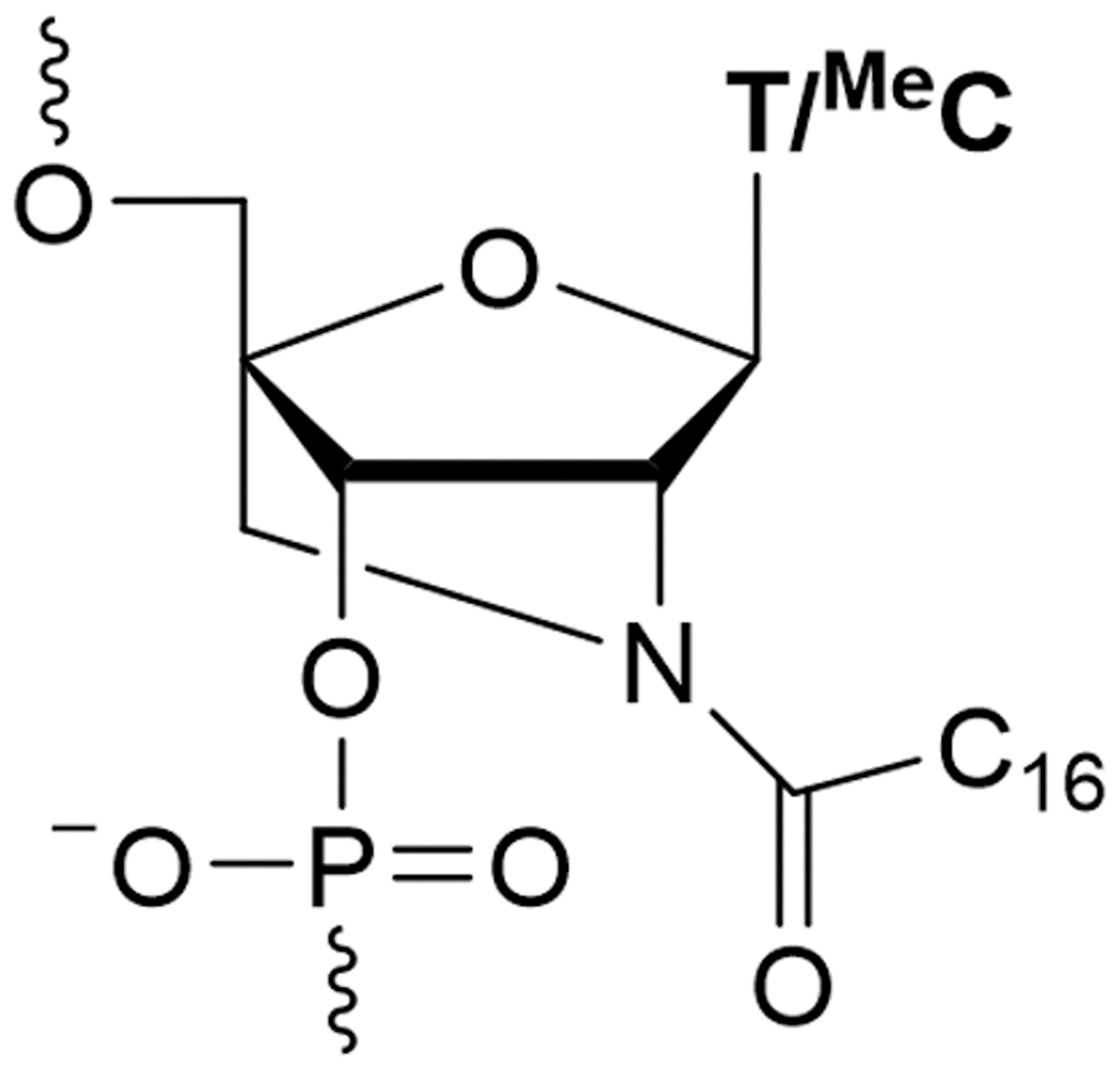
9. Le, Bao T.; Hughes, Quintin; Rakesh, Shilpa; Baker, Ross; Jørgensen, Per T.; Wengel, Jesper; Veedu, Rakesh N. Unlocked nucleic acid modified primer-based enzymatic polymerization assay: Towards allele-specific genotype detection of human platelet antigens. RSC Advances (2018), 8(57), 32770-32774. [Abstract]
Abstract: Accurate detection of single nucleotide polymorphisms (SNPs) is paramount for the appropriate therapeutic intervention of debilitating diseases associated with SNPs. However, in some cases current nucleic acid probes fail to detect allele-specific mutations, for example, human platelet antigens, HPA-15a (TCC) and HPA-15b (TAC) alleles associated with neonatal alloimmune thrombocytopenia. Towards this, it is necessary to develop a novel assay for detection of allele-specific mutations. In this study, we investigated the potential of unlocked nucleic acid (UNA)-modified primers in SNP detection utilising an enzymatic polymerisation-based approach. Our results of primer extension and asymmetric polymerase chain reaction by KOD XL DNA polymerase revealed that UNA-modified primers achieved excellent allele-specificity in discriminating the human platelet antigen DNA template, whereas the DNA control primers were not able to differentiate between the normal and mutant alleles, demonstrating the scope of this novel UNA-based enzymatic approach as a robust methodology for efficient detection of allele-specific mismatches. Although further evaluation is required for other disease conditions, we firmly believe that our findings offer a great promise for the diagnosis of neonatal alloimmune thrombocytopenia and other SNP-related diseases.
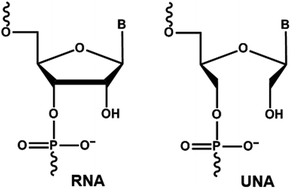
8. Ejlersen, Maria; Lou, Chenguang; Sanghvi, Yogesh S.; Tor, Yitzhak; Wengel, Jesper. Modification of oligodeoxynucleotides by on-column Suzuki cross-coupling reactions. Chem. Commun. (2018), 54, 8003–8006. [Abstract]
Abstract: The on-column functionalization of oligodeoxynucleotides via base-free Suzuki cross-coupling reactions is reported herein. These cross-coupling reactions were carried out with various boronic acids and either full-length modified oligonucleotides containing one or more 2'-deoxy-5-iodouridine (5IdU) monomer(s) or on oligonucleotide fragments immediately after incorporation of 5IdU. Five different functionalities were coupled to oligonucleotides containing one or three attachment points.
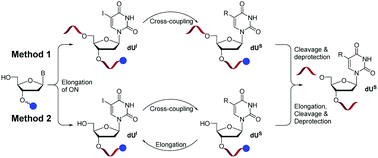
7. Loksha, Yasser M.; Pedersen, Erik B. Asymmetric synthesis of potential precursors of the HIV drug MC1220 and its analogues by hydrogenation of (1-arylvinyl)pyrimidines. J. Heterocyclic Chem. (2018), 55(6), 1352-1357. [Abstract]
Abstract: Because MC1220 is a promising microbicide with anti-HIV-1 activity, the possibility for asymmetric synthesis of its potential precursors is explored. Here, we investigate asymmetric reduction of the vinyl double bond of 6-(1-arylvinyl)pyrimidine derivatives to their corresponding ethylidene analogues. Catalysts with ligands bearing trivalent phosphorus ligating the soft metals rhodium(I), ruthenium(II), or iridium(I) are used for asymmetric reduction of the vinyl derivatives 5a–e. The enantioselective reduction reaches 92% ee and about 71% conversion for reduction of the 6-(1-(3,5-dimethylphenyl)vinyl)pyrimidine derivative 5b using the asymmetric catalyst catASium M(R)Rh (7m). However, for the more sterically hindered double bond in the corresponding 2,6-difluorophenyl derivative 5e, the enantioselective reduction dropped to 30% ee and 14% conversion.
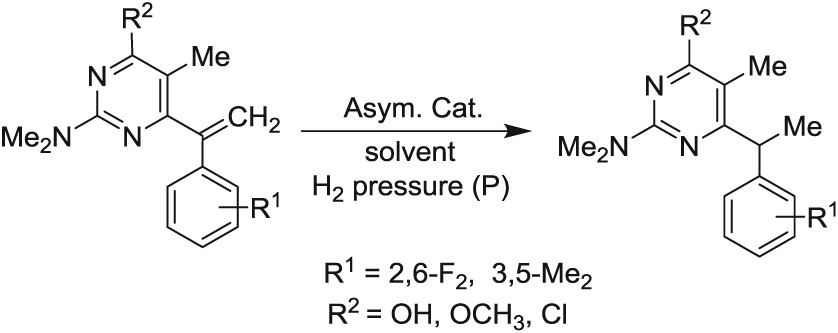
6. Lima, Joana F.; Carvalho, Joana; Pinto-Ribeiro, Ines; Almeida, Carina; Wengel, Jesper; Cerqueira, Laura; Figueiredo, Ceu; Oliveira, Carla; Azevedo, Nuno F. Targeting miR-9 in gastric cancer cells using locked nucleic acid oligonucleotides. BMC Molecular Biology (2018), 19 (6), [Abstract]
Abstract: Gastric cancer is the third leading cause of cancer-related mortality worldwide. Recently, it has been demonstrated that gastric cancer cells display a specific miRNA expression profile, with increasing evidence of the role of miRNA-9 in this disease. miRNA-9 upregulation has been shown to influence the expression of E-cadherinen coding gene, triggering cell motility and invasiveness.
In this study, we designed LNA anti-miRNA oligonucleotides with a complementary sequence to miRNA-9 and tested their properties to both detect and silence the target miRNA. We could identify and visualize the in vitro uptake of low-dosing LNA-based anti-miRNA oligonucleotides without any carrier or transfection agent, as early as 2 h after the addition of the oligonucleotide sequence to the culture medium. Furthermore, we were able to assess the silencing potential of miRNA-9, using different LNA anti-miRNA oligonucleotide designs, and to observe its subsequent effect on E-cadherin expression. The administration of anti-miRNA sequences even at low-doses, rapidly repressed the target miRNA, and influenced the expression of E-cadherin by significantly increasing its levels.
5. Moreno, P. M. D., Ferreira, A. R., Salvador, D., Rodrigues, M. T., Torrado, M., Carvalho, E. D., Tedebark, U., Sousa, M. M., Amaral, I. F., Wengel, J Pêgo, A. P. Hydrogel-assisted antisense LNA gapmer delivery for in situ gene silencing in spinal cord injury. Molecular Therapy - Nucleic Acids (2018), 11, 393-406. [Abstract]
Abstract: After spinal cord injury (SCI), nerve regeneration is severely hampered due to the establishment of a highly inhibitory microenvironment at the injury site, through the contribution of multiple factors. The potential of antisense oligonucleotides (AONs) to modify gene expression at different levels, allowing the regulation of cell survival and cell function, together with the availability of chemically modified nucleic acids with favorable biopharmaceutical properties, make AONs an attractive tool for novel SCI therapy developments. In this work, we explored the potential of locked nucleic acid (LNA)-modified AON gapmers in combination with a fibrin hydrogel bridging material to induce gene silencing in situ at a SCI lesion site. LNA gapmers were effectively developed against two promising gene targets aiming at enhancing axonal regeneration—RhoA and GSK3β. The fibrin-matrix-assisted AON delivery system mediated potent RNA knockdown in vitro in a dorsal root ganglion explant culture system and in vivo at a SCI lesion site, achieving around 75% downregulation 5 days after hydrogel injection. Our results show that local implantation of a AON-gapmer-loaded hydrogel matrix mediated efficient gene silencing in the lesioned spinal cord and is an innovative platform that can potentially combine gene regulation with regenerative permissive substrates aiming at SCI therapeutics and nerve regeneration.
4. Ejlersen, Maria; Christensen, Niels Johan; Sørensen, Kasper K.; Jensen, Knud J.; Wengel, Jesper; Lou, Chenguang. Synergy of two highly specific biomolecular recognition events: Aligning an AT-hook peptide in DNA minor grooves via covalent conjugation to 2'-amino-LNA. Bioconjugate Chemistry (2018), 29(4), 1025-1029. [Abstract]
Abstract:Two highly specific biomol. recognition events, nucleic acid duplex hybridization and DNA-peptide recognition in the minor groove, were coalesced in a miniature ensemble for the first time by covalently attaching a natural AT-hook peptide motif to nucleic acid duplexes via a 2'-amino-LNA scaffold. A combination of mol. dynamics simulations and UV thermal denaturation studies revealed high sequence-specific affinity of the peptide-oligonucleotide conjugates (POCs) when binding to complementary DNA strands, leveraging the bioinformation encrypted in the minor groove of DNA duplexes. The significant cooperative DNA duplex stabilization may pave the way toward further development of POCs with enhanced affinity and selectivity toward target sequences carrying peptide-binding genetic islands.
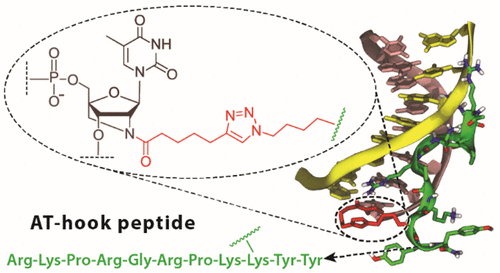
3. Kotkowiak, Weronika; Lisowiec-Wachnicka, Jolanta; Grynda, Jakub; Kierzek, Ryszard; Wengel, Jesper, Pasternak, Anna. Thermodynamic, anticoagulant, and antiproliferative properties of thrombin binding aptamer containing novel UNA derivative. Molecular Therapy: Nucleic Acids (2018), 10, 304-316 [Abstract]
Abstract: Thrombin is a serine protease that plays a crucial role in hemostasis, fibrinolysis, cell proliferation, and migration. Thrombin binding aptamer (TBA) is able to inhibit the activity of thrombin molecule via binding to its exosite I. This 15-nt DNA oligonucleotide forms an intramolecular, antiparallel G-quadruplex structure with a chair-like conformation. In this paper, we report on our investigations on the influence of certain modified nucleotide residues on thermodynamic stability, folding topology, and biological properties of TBA variants. In particular, the effect of single incorporation of a novel 4-thiouracil derivative of unlocked nucleic acid (UNA), as well as single incorporation of 4-thiouridine and all four canonical UNAs, was evaluated. The studies presented herein have shown that 4-thiouridine in RNA and UNA series, as well as all four canonical UNAs, can efficiently modulate G-quadruplex thermodynamic and biological stability, and that the effect is strongly position dependent. Interestingly, TBA variants containing the modified nucleotide residues are characterized by unchanged folding topology. Thrombin time assay revealed that incorporation of certain UNA residues may improve G-quadruplex anticoagulant properties. Noteworthy, some TBA variants, characterized by decreased ability to inhibit thrombin activity, possess significant antiproliferative properties reducing the viability of the HeLa cell line even by 95% at 10 μM concentration.
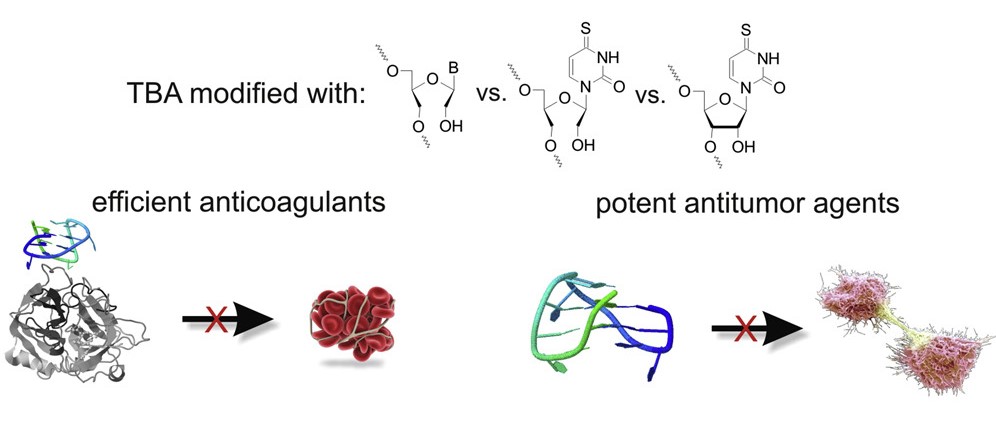
2. Vejlegaard, Kim; Wegeberg, Christina; McKee Vickie; Wengel, Jesper. Novel conformationally constrained 2′-C-methylribonucleosides: Synthesis and incorporation into oligonucleotides. Org. Biomol. Chem. (2018),16, 1312-1321 [Abstract]
Abstract: Synthesis of two novel conformationally constrained bicyclic ribonucleoside phosphoramidites bearing a 2′-C-methyl substituent has been accomplished. These phosphoramidites were used to incorporate the corresponding 2′-C-methyl nucleotides into oligonucleotides and to study their effects on duplex thermal stability. Whereas the C2′–O4′-linked LNA-type derivative induced severe destabilization of duplexes formed with complementary DNA and RNA, the C3′–O4′-linked derivative induced RNA-selective hybridization with increased affinity relative to that of the unmodified DNA-based probe.
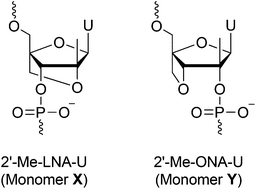
1. Cogoi, Susanna; Ferino, Annalisa; Miglietta, Giulia; Pedersen, Erik B; Xodo Luigi E. The regulatory G4 motif of the Kirsten ras (KRAS) gene is sensitive to guanine oxidation: implications on transcription. Nucleic acids research (2018), 46, 661-676. [Abstract]
Abstract: KRAS is one of the most mutated genes in human cancer. It is controlled by a G4 motif located upstream of the transcription start site. In this paper, we demonstrate that 8-oxoguanine (8-oxoG), being more abundant in G4 than in non-G4 regions, is a new player in the regulation of this oncogene. We designed oligonucleotides mimicking the KRAS G4-motif and found that 8-oxoG impacts folding and stability of the G-quadruplex. Dimethylsulphate-footprinting showed that the G-run carrying 8-oxoG is excluded from the G-tetrads and replaced by a redundant G-run in the KRAS G4-motif. Chromatin immunoprecipitation revealed that the base-excision repair protein OGG1 is recruited to the KRAS promoter when the level of 8-oxoG in the G4 region is raised by H2O2. Polyacrylamide gel electrophoresis evidenced that OGG1 removes 8-oxoG from the G4-motif in duplex, but when folded it binds to the G-quadruplex in a non-productive way. We also found that 8-oxoG enhances the recruitment to the KRAS promoter of MAZ and hnRNP A1, two nuclear factors essential for transcription. All this suggests that 8-oxoG in the promoter G4 region could have an epigenetic potential for the control of gene expression.